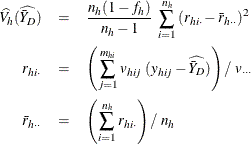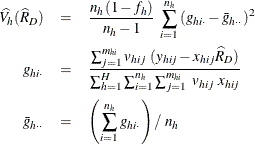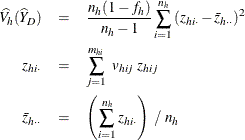The SURVEYMEANS Procedure
When you use a DOMAIN statement to request a domain analysis, the procedure computes the requested statistics for each domain.
For a domain D, let ![]() be the corresponding indicator variable:
be the corresponding indicator variable:
Let
Let
The requested statistics for variable y in domain D are computed by using the new weights v.
Note that ![]() is set to missing if
is set to missing if ![]() represents a level of a categorical variable and
represents a level of a categorical variable and ![]() is missing.
is missing.
The estimated mean of y in the domain D is
where
The variance of ![]() is estimated by
is estimated by
where, if ![]() , then
, then

and if ![]() , then
, then
The estimated ratio of Y to X in domain D is
and its estimated variance is
where, if ![]() , then
, then

and if ![]() , then
, then
For domain analysis with poststratification, see the section Poststratification. For quantile estimation in a domain, see the section Domain Quantile. For quantile estimation in a domain with poststratification, see the section Domain Quantile Estimation with Poststratification.

